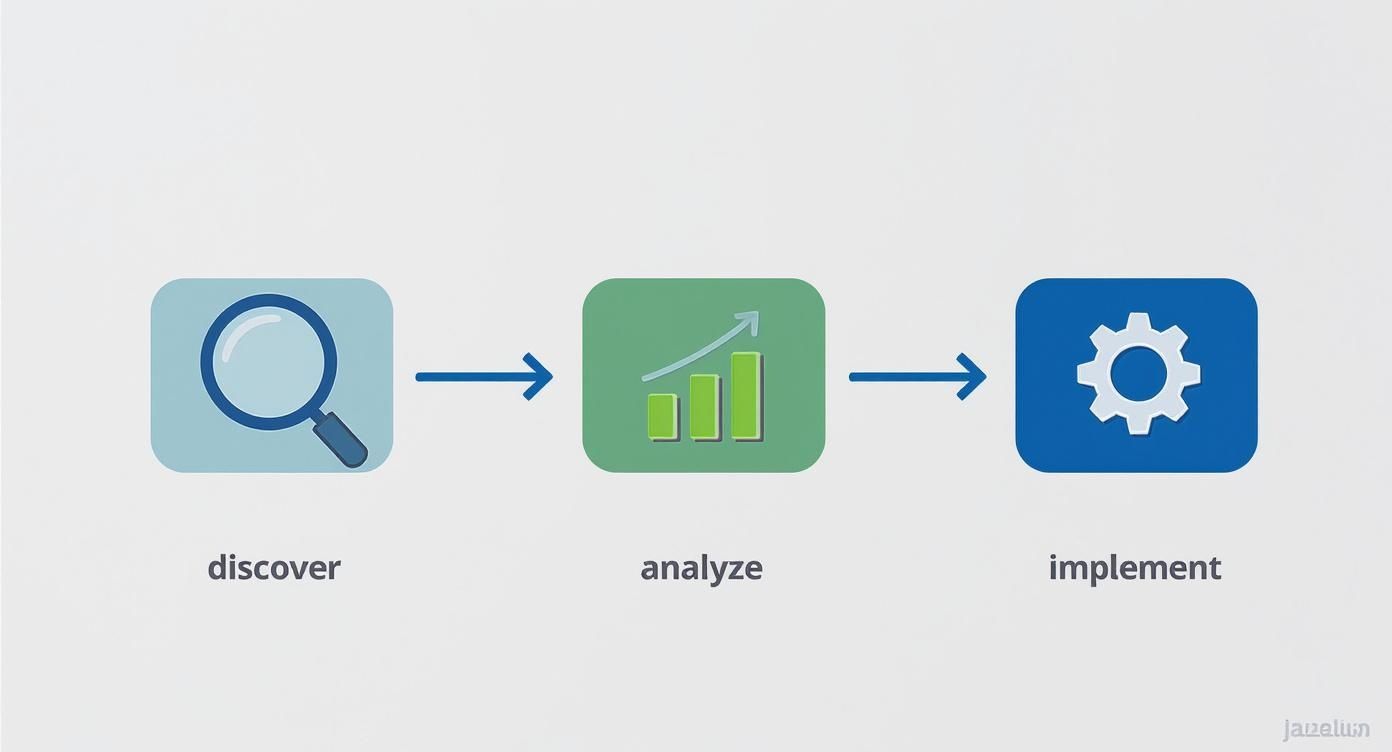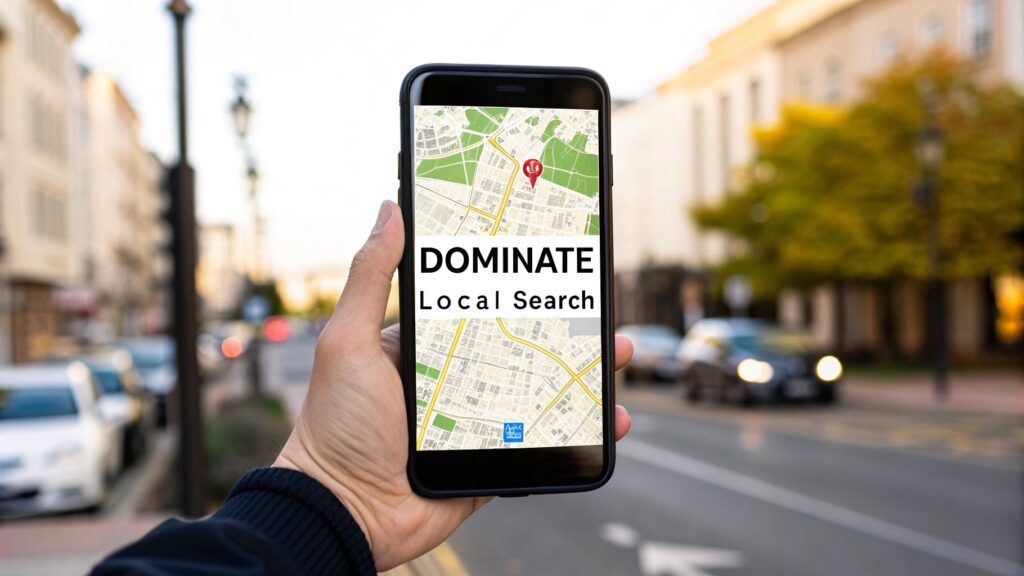You’re an expert at eye care, not digital marketing. You’re busy running a practice, and learning how to get your website to show up on Google is probably the last thing on your to-do list.
But here’s a simple fact: your next patient isn’t looking you up in the phone book. They’re searching online for things like "eye doctor near me."
This is why SEO for optometrists is so important. It’s the most direct way to connect with people who are actively looking for your services right now.
In Short: SEO helps your practice show up at the top of Google search results, making it easy for local patients to find and book appointments with you.
Why Your Optometry Practice Needs SEO

Think of search engine optimization (SEO) as the digital front door to your clinic. It’s all about making your online presence better so that when someone in your area needs an eye exam, your practice is the first one they find. If you ignore SEO, you're essentially invisible to a huge number of potential patients.
A good SEO strategy makes your practice the best answer Google can give for local eye care. It helps you get noticed over the competition and builds trust before a patient even walks in.
Connect With Patients Ready to Book
SEO puts you right in front of people who are searching for help. They have a real need—blurry vision, an old prescription, or a sudden eye problem—and they want a solution now.
When your website appears for searches like "optometrist in [Your City]" or "pediatric eye exams near me," you're reaching people who are serious about booking. These aren't just casual browsers; they're your next appointments.
Outrank Your Local Competitors
Most towns have at least a few optometry practices competing for the same patients. Who wins? The one that shows up first on Google, especially in the Google Map Pack.
Being visible in local search isn't just about getting more website clicks. It's about establishing your practice as the go-to authority for eye care in your community. A high ranking sends a powerful signal of credibility and makes you the obvious choice.
The demand for eye care is growing. Routine exams in the US are expected to hit 113.4 million annually by 2025. Medical eye care exams are projected to jump by over 31%. A smart SEO strategy positions your practice to get a piece of this growing patient base. You can learn more about future optometry trends and what they mean for your business.
What’s the most important part of SEO for an optometrist?
If you focus on one thing, it should be local SEO.
Local SEO is all about making your practice visible to people in your immediate area. Patients want convenience, so showing up in their local search is a must.
A winning local strategy includes a few key things:
- Google Business Profile: Your Google Business Profile needs to be completely filled out, accurate, and full of positive reviews.
- Local Keywords: Naturally include your city and neighborhood names in your website content.
- Online Directories: Keep your name, address, and phone number consistent across sites like Yelp and Healthgrades.
Get these local search basics right, and you'll make sure that when someone nearby needs an eye doctor, your practice is the first one they find.
Finding the Keywords Real Patients Use
To show up on Google, you have to think like a potential patient. What are they actually typing into the search bar when they need an eye exam? Getting this right is the foundation of good SEO for optometrists.
The goal is to understand search intent. You want to find keywords that show someone is ready to book an appointment, not just research an eye condition.
Start with Obvious Local Keywords
Patients search locally. This is your low-hanging fruit.
Think about the simplest, most direct searches:
- optometrist in [Your City]
- eye doctor near me
- eye exam [Your Neighborhood]
These are your core keywords. Start by listing every town and neighborhood you serve. Then, pair them with your main services.
Dig Deeper with Service-Specific Terms
You do more than just general eye exams. Do you have specialties? Patients with specific problems use more targeted search terms.
Think about services like:
- Dry eye treatment: "best dry eye doctor in dallas"
- Pediatric eye care: "kids eye exams houston"
- Contact lens fittings: "contact lens fitting near me"
- Glaucoma testing: "glaucoma specialist miami"
A great strategy is to create a separate page on your website for each of these services. Optimizing those pages for specific phrases tells Google you're an expert in that area.
Find Hidden Gems with Long-Tail Keywords
This is where you can get ahead of your competition. Long-tail keywords are longer, more conversational phrases people use when they are close to making a decision. Fewer people search for them, but those who do are often ready to book an appointment right away.
For example, a parent might not just search for "kids eye exams." Their search could be more specific, like:
- "best place for kids eye exam with medicaid"
- "pediatric optometrist that takes VSP insurance"
- "emergency eye doctor for child's scratched cornea"
To find these, just think about the questions your staff answers all day. Each specific concern, insurance question, or urgent problem is a valuable long-tail keyword.
You can use free tools like Google's Keyword Planner to get started.
This tool shows you what people are searching for and how many people are searching for it each month. This helps you focus your efforts.
If you want to learn more, this guide on how to use Google's Keyword Planner is a great resource. Building a smart keyword list is the first step to an SEO plan that brings in new patients.
Winning the Local SEO Game in Your Neighborhood
For an optometrist, local search is everything. When someone's vision gets blurry, they search for an "eye doctor near me."
Your goal is to be the first name they see. Getting your practice into the Google Map Pack is how you turn those searches into new patients.
Your Google Business Profile Is Your Digital Front Door
Your Google Business Profile (GBP) is your most important online asset. It's the info box that appears in Google Maps and search results, showing your hours, address, phone number, and reviews.
If you neglect it, you're losing potential patients. Here’s how to do it right:
- Be Specific with Categories: Your main category should be "Optometrist." But add secondary categories like "Eye Care Center," "Contact Lenses Supplier," or "Sunglass Store."
- Fill In Everything: Add detailed service descriptions, list the insurance plans you accept, and use the Q&A section to answer common questions.
- Show, Don't Just Tell: Upload high-quality photos of your staff, your reception area, your equipment, and the outside of your building.
The Power of NAP Consistency
NAP stands for Name, Address, and Phone number. Google looks for consistent information across the web to verify your practice is legitimate. When it sees the exact same NAP on your website, GBP, Yelp, and other directories, it builds trust.
Small differences, like using "St." on one site and "Street" on another, can hurt your local rankings.
In Short: A consistent NAP is a strong trust signal for Google. It confirms you are a real local business, making Google more likely to recommend you.
How to Get More Patient Reviews
Reviews are extremely important. They are a huge ranking factor for local search and provide social proof that your community trusts you.
Here's a simple way to get more reviews:
- Ask at the Right Time: The best time to ask is right after a patient has had a great experience.
- Make It Easy: Send a follow-up email or text with a direct link to the review section of your Google Business Profile.
- Keep it Simple: A friendly, "We'd love to hear your feedback on Google" is often all you need.
Just remember not to offer rewards for reviews, as this is against Google's policies. The key is to build this simple "ask" into your normal post-appointment process.
For a deeper dive, our guide on mastering local maps SEO has more advanced strategies.
Here’s a look at the process for attracting local patients through search.

A winning local strategy starts with understanding what your patients are searching for and then acting on that knowledge.
Key Local SEO Focus Areas for Optometrists
| Activity | Why It's Important | Quick Tip |
|---|---|---|
| Google Business Profile (GBP) Optimization | It's your digital storefront and the #1 factor for Map Pack rankings. | Use the "Posts" feature weekly to share updates, offers, or news to keep your profile active. |
| NAP Consistency | Builds trust with Google and ensures patients have the correct contact info. | Use a tool like Moz Local to audit your listings and find inconsistencies quickly. |
| Online Review Management | Social proof drives bookings and directly impacts your local ranking. | Always respond to reviews—both positive and negative. It shows you're engaged and you care. |
| Local Link Building | Links from other local businesses signal community relevance. | Sponsor a local youth sports team or charity event in exchange for a link from their website. |
Focusing on these areas will give you the biggest impact in attracting local patients. The U.S. optometry market is now valued at over $1.7 billion and growing. Dominating local search is the most direct way to claim your piece of it. Keeping up with current optometry marketing trends will also ensure your practice stays ahead.
Creating Website Content That Builds Trust

Your website is often the first interaction a potential patient has with your practice. To get them to book an appointment, your site needs to be genuinely helpful and build immediate trust.
Great content helps you do this. Your goal is to answer a visitor’s questions before they even have to ask. When you do that, your site becomes a trusted resource, guiding people toward scheduling a visit.
Must-Have Website Pages
Every optometry website needs a few core pages. These are the essentials that both Google and your future patients expect to find.
- A Welcoming Homepage: It needs to immediately show who you are, what you do, and where you're located. A clear "Book an Appointment" button is a must.
- Detailed Service Pages: Don't just list "Eye Exams." Create separate pages for 'Comprehensive Eye Exams,' 'Contact Lens Fittings,' 'Pediatric Eye Care,' and 'Dry Eye Treatment.' This helps you rank for specific search terms.
- An "About Us" Page: Share your practice's story and introduce your doctors with friendly photos. Talk about your approach to patient care.
- A Clear Contact Page: Include your address, phone number, hours, and an embedded Google Map. Make it easy for people to find you.
How do I come up with blog topics?
Blogging is your secret weapon. It’s how you answer the real-world questions your patients ask every day. This proves you're an expert and builds a library of helpful content that attracts search traffic.
Stuck on ideas? Start with common problems you solve:
- "5 Signs Your Child Might Need Glasses"
- "LASIK vs. Contact Lenses: What's Right for Me?"
- "How to Reduce Digital Eye Strain When Working From Home"
- "Understanding Your Vision Insurance Benefits"
In Short: The best blog topics come from your exam room. If a patient asks a question, others in your area are likely Googling the same thing.
The top 50 optical retailers in the U.S. generated about $21 billion in revenue, a 4% increase year-over-year. As a key part of this industry, strong SEO is your way to tap into that market.
Become the Go-To Resource
Your website should be the most reliable local source for eye health information. This means creating content that clearly explains services, like offering comprehensive information about eye exams. The more helpful you are online, the more Google will see your practice as an authority worth recommending.
This principle works across specialized medical fields. For example, the same strategies are used in SEO for audiologists, where patient education is also critical. The idea is always the same: be the best and most helpful answer.
Building Your Practice's Online Authority
In SEO for optometrists, "authority" is another word for trust. When Google sees other reputable websites linking to yours, it views you as a more credible source. This trust is built through backlinks.
A backlink is like a vote of confidence from another website. When another site links to yours, they’re telling Google your content is valuable. The more high-quality "votes" you get, the more authoritative you look, which helps you rank higher.
What is a good backlink for an optometrist?
Not all backlinks are helpful. A random link from an unrelated blog won't do much. You want links from sources that are trusted, relevant, and local.
Good backlinks for an optometrist usually come from:
- Local community websites, like your Chamber of Commerce or a local news blog.
- Other healthcare practices, like a pediatrician or family doctor who refers patients to you.
- Local events you sponsor, like a 5k run or a charity.
Simple Ways to Earn Quality Backlinks
Getting backlinks doesn't have to be complicated. The best opportunities often come from getting involved in your local community.
Here are a few simple ideas:
- Sponsor a Local Youth Sports Team: Most teams list their sponsors on their website. Ask them to include a link to your practice’s website.
- Team Up with a Nearby Doctor: Offer to write a guest post for a local doctor's blog on a topic like "When Should My Child Have Their First Eye Exam?" They'll link back to your site as the author.
- Get Featured in a Community Newsletter: Offer to contribute a quick eye health tip to your town or HOA's digital newsletter. They are often looking for content from local experts.
In Short: Bridge your real-world community work with your online presence. Every partnership and sponsorship is a potential backlink.
Your Top SEO Questions, Answered
It's normal to have questions. Let's cover the ones that come up most often.
How long does SEO take to work for an optometrist?
SEO is a long-term investment, not a quick fix.
You will likely start seeing some positive movement, like better rankings and more website traffic, within the first 3 to 6 months. But to get a steady stream of new patients booking appointments, you're usually looking at 6 to 12 months. It depends on how competitive your area is. The key is to be patient and consistent.
Can I do SEO myself or do I need an agency?
You can definitely get started on your own.
Here are a few things you can do yourself right now:
- Complete your Google Business Profile. Fill out every single section and add plenty of photos.
- Ask for reviews. Make it a routine to ask happy patients for a Google review.
- Check your website info. Make sure your address and phone number are correct and easy to find.
The more technical side of SEO, like creating content, building links, and fixing website code, takes a lot of time. If you're busy running your practice, hiring a marketing partner who understands the eye care industry can get you better results, faster.
Is SEO important for an optometry practice?
Yes, it is very important. Even if you get a lot of referrals, the way people find and choose businesses has changed.
When a patient is referred by a friend, the first thing they do is Google you. They want to check your hours, see your location, and read your reviews. A strong online presence validates that referral and makes a great first impression.
A perfectly optimized Google Business Profile, consistent information across online directories, and a steady flow of great patient reviews are the three pillars that will drive people to your door.
Ready to stop worrying about where your next patient is coming from? The team at Clicks Geek lives and breathes this stuff, helping local practices like yours grow. Let's build a plan that gets you seen.
Is Your Business Ranking in Google Maps?
Turn Google Maps into a Lead Engine w/ Clicks Geek’s AI-powered local SEO. 3,000+ clients served. Our proprietary, fully done-for-you Maps SEO system handles everything—keyword targeting, local optimization, content, reviews, and ranking strategy—automatically.






